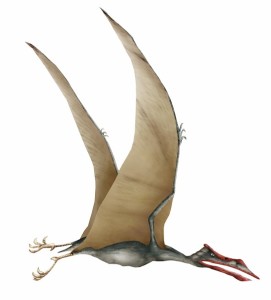Updated on: 04/04/2022
Quetzalcoatlus is an extinct genus of pterosaur belonging to the clade Pterosauria. It is accounted as the largest flying reptile that has ever lived on earth. It is believed that they were quite abundant among a fauna dominated by Alamosaurus.
| Kingdom: | Animalia |
| Phylum: | Chordata |
| Order: | Pterosauria |
| Suborder: | Pterodactyloidea |
| Family: | Azhdarchidae |
| Genus: | Quetzalcoatlus |
| Type species: | Quetzalcoatlus northropi |
| Pronunciation: | KWET-zal-koh-AT-lus |
| Geological Time Period: | Maastrichtian stage, Late Cretaceous |
| Size (height): | 10 – 11 meter |
| Wingspan: | 10 –11 meters (33–36 ft) |
| Weight: | 440 – 550 lb |
| Environment/Habitat: | semi-arid inland plains |
| Range/Location: | North America |
| Diet: | Carnivore |
| Beak length: | 8ft – 10 ft |
| Birth type: | Eggs |
Quetzalcoatlus is noted for its gigantic appearance. It had long, elongated neck; stork-like toothless jaws; and sharp, long and pointed beak. It also had a skull crest, but researchers have not been able to determine its size. It has been suggested that they had a large brain. They also possessed big eyes that sparked good eyesight hypothesis. Their body was covered with fur like hair.
In 1971, the first Quetzalcoatlus bone samples (dated to approximately 68 million years) were found in the Maastrichtian Javelina Formation at Big Bend National Park in Texas, United States. It was encountered by Douglas A. Lawson, a geology graduate student. Later Lawson and Texas Memorial Museum Professor Wann Langston, Jr. discovered three fragmentary skeletons of smaller specimens. In 1975, Prof. Langston Jr. named the large sample (TMM 41450-3) as the type specimen of a new genus and species.

First it was believed that the small species were actually juveniles; but later, with the discovery of more remains, it was believed that there is a second species that was provisionally named Quetzalcoatlus sp. by Alexander Kellner and Langston in 1996. It was suggested that it was too early to refer it with a full species name.
In 2002, an azhdarchid neck vertebra was found from the Maastrichtian age Hell Creek Formation. It is believed that the fossil sample belongs to Quetzalcoatlus. It has been estimated that the individual had a wingspan of 16–18 ft.
The name of this genus has derived from Quetzalcoatl, the Mesoamerican feathered serpent god. And, the name ‘northropi’ honors aircraft industrialist, designer and the founder of Northrop Corporation John Knudsen Northrop, who was fond of huge tailless flying wing aircraft designs matching the appearance of Quetzalcoatlus.
There have been several hypotheses when it comes to their behavior and lifestyle. In 1975, Lawson suggested that Quetzalcoatlus was a scavenger, but that idea was rejected by Thomas Lehman and Langston, in 1996. The duo described that they fed like present-day skimmers. Later in 2008, Mark Paul Witton and Darren Naish rejected the idea saying that this type of adaptation would cost too much energy because of the excessive drag. More importantly, most azhdarchid remains have been unearthed inland, far from large water bodies. Therefore, the skimming hypothesis cannot be backed. It was suggested that they fed on small vertebrates like modern storks.
Whether Quetzalcoatlus could fly or not has always been a matter of controversy. Some scientists have suggested that they could generate fast and dynamic flight; while some believe that their flight was slow and soaring. Donald Henderson, in 2010, said that Quetzalcoatlus was flightless as its mass was too heavy to generate powered flight. However, his suggestion was denied by Chatham University biomechanics professor Mike Habib and British paleontologist Mark Witton. Habib added that Q. northropi’s maximum flight range was 8000 to 12000 miles.
